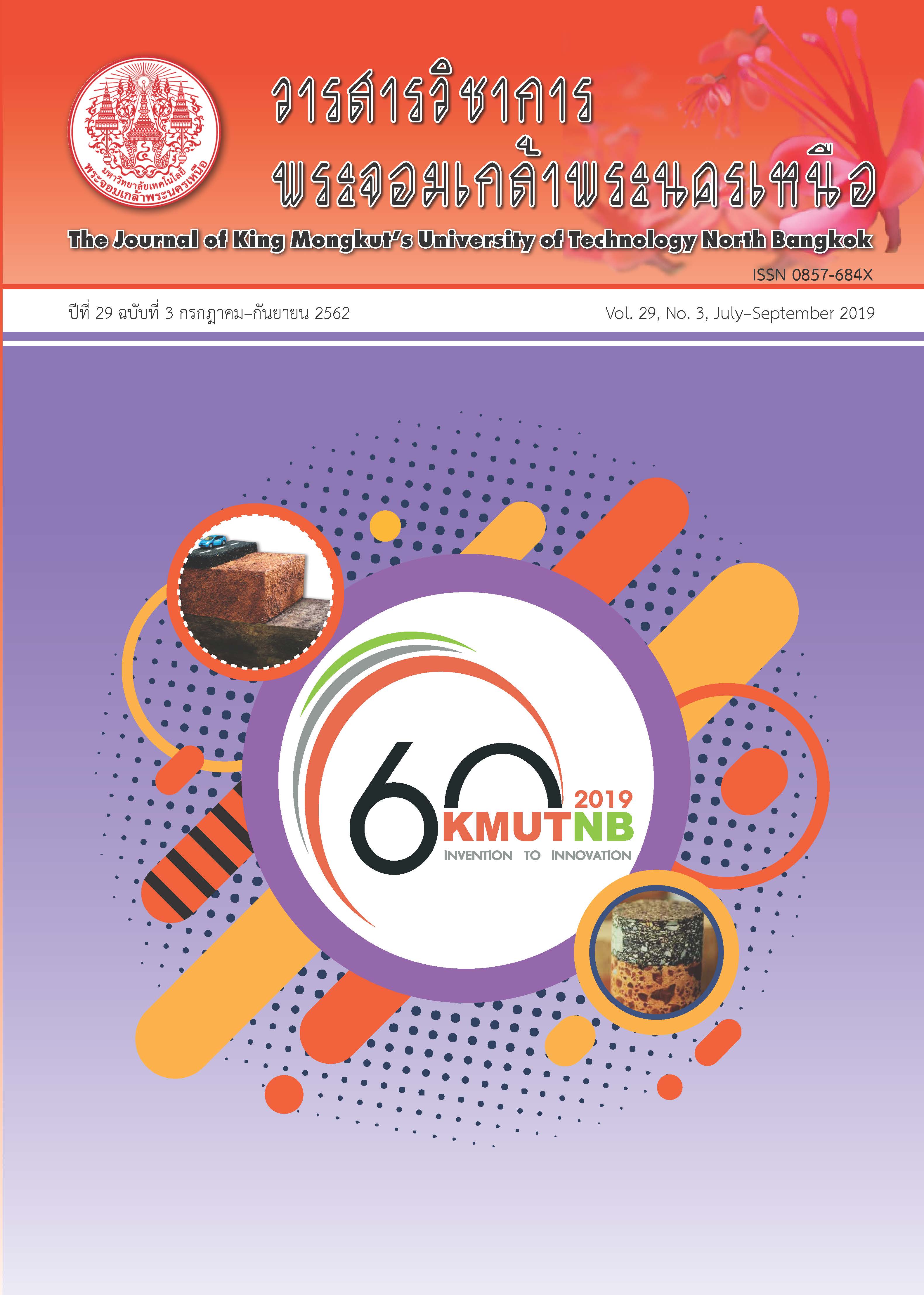การประยุกต์ใช้ระบบสารสนเทศภูมิศาสตร์เพื่อประเมินพื้นที่เสี่ยงน้ำท่วมและพื้นที่รับน้ำ กรณีศึกษาพื้นที่ทางทิศใต้ของจังหวัดสุพรรณบุรี
Main Article Content
บทคัดย่อ
งานวิจัยนี้มีวัตถุประสงค์เพื่อประเมินพื้นที่เสี่ยงน้ำท่วมและประเมินพื้นที่รองรับน้ำของ 4 อำเภอตอนล่างของจังหวัดสุพรรณบุรี ด้วยระบบสารสนเทศภูมิศาสตร์ การวิเคราะห์แบบลำดับชั้นในวิธีการวิเคราะห์การตัดสินใจหลายหลักเกณฑ์สำหรับจำลองพื้นที่เสี่ยงน้ำท่วมใช้ปัจจัยสำหรับศึกษา 5 ปัจจัย ได้แก่ ปริมาณน้ำฝน การระบายน้ำของดิน ความลาดชัน ระยะห่างจากแหล่งน้ำ และการใช้ประโยชน์ที่ดิน ส่วนการประเมินพื้นที่รองรับน้ำใช้ 3 ปัจจัย ได้แก่ ความลาดชัน ระยะห่างจากแหล่งน้ำและการใช้ประโยชน์ที่ดิน ผลการศึกษาพบว่า พื้นที่ส่วนใหญ่เสี่ยงอยู่ในระดับปานกลาง คิดเป็นร้อยละ 44.12 และพื้นที่เสี่ยงสูงคิดเป็นร้อยละ 29.15 พื้นที่เสี่ยงเกิดน้ำท่วมมาก ได้แก่ พื้นที่อำเภอบางปลาม้าและอำเภอสองพี่น้อง ในส่วนของพื้นที่เหมาะสมมากสำหรับพัฒนาเป็นพื้นที่รองรับน้ำมีพื้นที่เท่ากับ 849 ตร.กม. คิดเป็นร้อยละ 22.19 ของพื้นที่ทั้งหมด จากการเปรียบเทียบแบบจำลองพื้นที่เสี่ยงน้ำท่วมและพื้นที่รองรับน้ำ พบว่ามี 4 พื้นที่เหมาะสมนำมาพัฒนาเป็นพื้นที่รองรับน้ำ คือ พื้นที่ตำบลจรเข้สามพันในอำเภออู่ทอง พื้นที่ตำบลบางตะเคียนในอำเภอสองพี่น้อง พื้นที่ตำบลตลิ่งชันในอำเภอเมือง และพื้นที่รอยต่อระหว่างตำบลโคกโคเฒ่าอำเภอเมืองและตำบลโคกครามอำเภอบางปลาม้า
Article Details
บทความที่ลงตีพิมพ์เป็นข้อคิดเห็นของผู้เขียนเท่านั้น
ผู้เขียนจะต้องเป็นผู้รับผิดชอบต่อผลทางกฎหมายใดๆ ที่อาจเกิดขึ้นจากบทความนั้น
References
[2] A. Singh, “Hydrological problems of water resources in irrigated agriculture: A management perspective, India,” Journal of Hydrology, vol. 541, pp. 1430–1440, 2016.
[3] P. Eksiripong and S. Jirakajohnkool, “Geographic information systems application for flood hazard analysis, in Chiang Mai municipality,” Thai Journal of Science and Technology, vol. 3, no. 3, pp. 148–159, 2014 (in Thai).
[4] S. Eiamprasert, “Comparison of spatial daily rainfall amount interpolation methods by using geographic information system for Chao-Phra-Ya watershed,” M.S. thesis, National Institute of Development Administration, 2011 (in Thai).
[5] L. Noichaisin, “Application of GIS on flood risk area assessment in Sa Kaeo province,” Burapha Science Journal, vol. 21, no. 1, pp. 51–63, 2016 (in Thai).
[6] T. Kaewpumpuang and J. Payakpate, “Decision support system for sugarcane seed selection - A case study: Kamphaengphet,” Science and Technology RMUTT Journal, vol. 6, no. 1, pp. 110–121, 2016 (in Thai).
[7] V. Vudhivanich, “Applied hydrology,” Department of Irrigation Engineering, Faculty of Engineering, Kasetsart University, Kamphaeng Saen Campus, 1996 (in Thai).
[8] A. Saravisutra, “Multi-criteria decition making: Comparison between SAW, AHP, TOPSIS concept and methods,” Princess of Naradhiwas University Journal, vol. 8, no. 2, pp. 180–192, 2016 (in Thai).
[9] P. N. Rekha, R. Gangadharan, P. Ravichandran, A. Mahalakshmi, A. Panigrahi, and S. M. Pillai, “Assessment of impact of shrimp farming on coastal groundwater using geographical information system base analytical hierarchy process,” Aquaculture, vol. 448, pp. 491–506, 2014.
[10] I. Elkhrachy, “Flash flood hazard mapping using satellite image and GIS tools: A case study of Najran City, Kingdom of Saudi Arabia (KSA),” The Egyptian Journal of Remote Sensing and Space Sciences, vol. 18, no.2, pp. 261–278, 2015.
[11] A. Adham, M. Riksen, M. Ouessar, and C. Ritsema, “Identification of suitable sites for rainwater harvesting structures in arid and semi-arid regions: A review,” International Soil and Water Conservation Research, vol. 4, pp. 108–120, 2016.
[12] R. Sven-Erik, R. Gantenbein, R. Kai-Florian, and A. Gret-Regamey, “Increasing the credibility of expert-based models with preference surveys – Mapping recreation in the riverine zone,” Ecosystem Services, vol. 31, pp. 308–317, 2017.
[13] P. Qi and M. Du, “Multi-factor evaluation indicator method for the risk assessment of atmospheric and oceanic hazard group due to the attack of tropical cyclones,” International Journal of Applied Earth Observation and Geoinformation, vol, 68, pp. 1–7, 2018.
[14] R. Hariat, A. Roozbahani, and A. Ebrahimian, “Risk analysis of urban stromwater infrastructure system using fuzzy spatial multi-criteria decision making,” Science of the Total Environment, vol. 647, pp. 1468–1477, 2018.
[15] N. Kazaki, L. Kougias, and T. Patsialis, “Assessment of flood hazard areas at a regional scale using an index-based approach and analytical hierarchy process: Application in Rhodope-Evros region, Greece,” Science of The Total Environment, vol. 538, pp. 555–563, 2015.
[16] K. Seejata, A. Yodying, T. Wongthadam, N. Mahavik, and S. Tantanee, “Assessment of flood hazard areas using analytical hierarchy process over the lower Yom Basin, Sukhothai Province,” Procedia Engineering, vol. 212, pp. 340–347, 2017 (in Thai).
[17] X. Tang, Y. Shu, Y. Lian, Y. Zhao, and Y. Fu, “A spatial assessment of urban waterlogging risk based on a weighted Naïve Bayes classifier,” Science of the Total Environment, vol. 630, pp. 264–274, 2018.
[18] Y. Xiao, S. Yi, and Z. Tang, “Integrated flood hazard assessment based on spatial ordered weighted averaging method considering spatial heterogeneity of risk preference,” Science of the Total Environment, vol. 599–600, pp. 1034–1046, 2017.
[19] Information and Communication center Suphanburi. (2009). Suphanburi Provincial Governor’s Office. Suphanburi, Thailand [Online]. Available: http://www.suphanburi.go.th
[20] Thai Meteorological Department. (2017). Thailand Annual Weather Summary. Bangkok, Thailand [Online]. Available: https://www.tmd.go.th/climate/climate.php?FileID=5.
[21] Department of Disaster Prevention and Mitigation. (2012). Ministry of interior. Bangkok, Thailand [Online]. Available: http://www.disaster.go.th/th/cdetail-7115-disaster_new-142-3/ปภ.รายงานสถานการณ์น?้ำท่วม.
[22] ESRI, ArcGIS Desktop: Release 10. Redlands, CA: Environmental Systems Research Institute, 2011.
[23] Office of Environmental Policy and Planning, Risk Area Classification for Natural Hazards in Northern Watersheds. Ministry of Science and Technology, Bangkok, 1998.
[24] P. Cabala, “Using the analytic hierarchy process in evaluating decision alternatives,” Operation Research and Decision, vol. 20, no.1, pp. 1–23, 2010.
[25] T. L. Saaty, The Analytic Hierarchy Process. New York: McGraw-Hill, 1980.
[26] W. Akkanipat, “The objective of this research is to analyze the suitable location for palm oil extraction factories in Chumphon Province,” Journal of Remote Sensing and GIS Association of Thailand, vol. 10, no. 3, pp. 13–26, 2009 (in Thai).
[27] J. Vichiansinpa, N. Wongram, and C. Wantong, “Application of geographic information system on sanitary landfill site selection: A case study of Lam Plai Mat district, Buriram Province,” Rommayasan, vol. 13 no. 2, pp. 19–32, 2015 (in Thai).
[28] S. Dhanarun and J. Amornsanguansin, “Application of geographic information system for flood risk area assessment in angthong province,” Journal of Environmental Management, vol. 6, no. 2, pp. 19–34, 2010 (in Thai).
[29] Geo-Informatics and Space Technology Development Agency. (2007). Thailand Flood Monitoring System. Geo-Informatics and Space Technology Development Agency. Bangkok, Thailand [Online]. Available: http://flood.gistda.or.th
[30] E. H. Leea and J. H. Kim, “Development of a flood-damage-based flood forecasting technique,” Journal of Hydrology, vol. 563, pp. 181–194, 2018.
